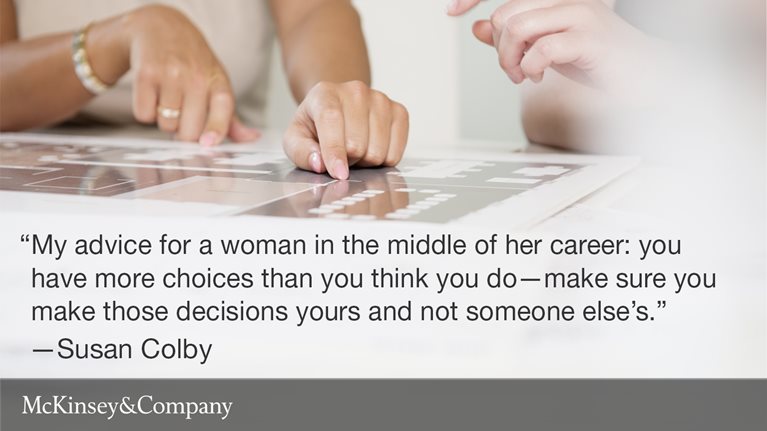Recently we’ve redoubled our efforts on gender equality, committing to initiatives such as UN Women’s HeForShe and Australia’s Male Champions of Change, as well as publishing major research reports including The power of parity (from the McKinsey Global Institute) and Women in the workplace (in partnership with Sheryl Sandberg’s LeanIn.Org.) Among the sobering takeaways from the research: at a macro level, global GDP realistically could increase by $12 trillion if women participated in the workforce on more equal terms with men. Yet, at a micro level, at the current rate of progress, US companies are still decades—or perhaps even a century—away from achieving gender parity at every level of the organization.
Our goal is to galvanize and inform action on this critical economic and social issue. To get behind the numbers, we asked three senior McKinsey women to reflect on the research from the perspective of accomplished professionals. What resonates with them, and why?
The Women in the workplace research revealed that women remain underrepresented at every stage of the talent pipeline. Among the companies surveyed, women account for 45 percent of employees at the entry level, but the number drops dramatically to 32 percent by midcareer and 17 percent at the top level of the organization. It's important that companies look at multiple ways to address this issue. Says Celia Huber, a McKinsey director: “Sponsorship is everything. A sponsor can create opportunities, instill confidence to make the most of those opportunities, and provide inspiration when times are tough.”

McKinsey principal Kara Carter agrees: “The sponsorship point really hit home for me. I’ve had the tremendous benefit of wonderful sponsors—women and men—without whom I would not be where I am today. The research encouraged me to focus on making sure women I care about are connecting not just with women sponsors but also with senior men who can create meaningful opportunities for them.”
Another key finding is that less than half of employees believe that gender diversity is a top priority for their CEO, even though 74 percent of companies report that their CEO is highly committed to diversity. For a variety of reasons, top management commitments often do not seem to be translating into changes in women's day-to-day reality in the workplace. The research showed, for example, that although many programs facilitate flexible working, employees often don’t participate for fear of damaging their career prospects. Tackling these issues requires acknowledging and changing the unconscious biases held by both men and women at senior levels.
“The idea that you can have real meritocracy when decision makers are all one type is on its face not valid,” McKinsey principal Susan Colby says. “It speaks to an ongoing challenge: unconscious bias in the workplace.”
One common theme arising from The power of parity and Women in the workplace is the disproportionate share of unpaid care work—everything from child care and elder care to cooking and domestic chores—carried out by women around the world. Even in supposedly developed economies, this imbalance leaves many women feeling boxed in and unable or unwilling to take career risks.
Says Susan: “I think many women make decisions that are someone else’s: a society or a culture or a husband that doesn’t want them to work. If you don’t understand yourself and your choices, you live someone else’s life and never discover your own equilibrium. My biggest wish for women in the thick of it is that they empower themselves to make their own decisions.”